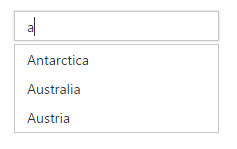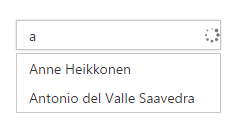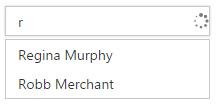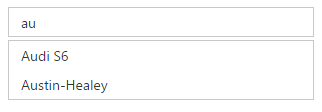Data Binding
7 Jun 202314 minutes to read
In order to render the Autocomplete widget, the data needs to be bound to it in a proper way. The below sections explain about binding local or remote data to the Autocomplete widget.
Fields
The Autocomplete widget has a field property (object) which holds the properties to map with dataSource fields. Whenever we bind a data to Autocomplete, corresponding fields must be mapped using this property.
The field object contains the following properties.
| Fields property | Description |
|---|---|
| text | Maps the display text in the suggestion list |
| key | Maps to the unique key field in the data source |
| groupBy | Allows to enable grouping based on the assigned field |
| htmlAttributes | Maps to set the HTML attribute for the list items |
Local data
The local data must be an array of JSON objects which is assigned for the Autocomplete widget dataSource property.
In the below example name and index fields are mapped with text and key properties of the field object respectively.
<input type="text" id="autocomplete" />
<script type="text/javascript">
var countriesField = [
{ name: "Austria", index: "C1" },
{ name: "Australia", index: "C2" }, { name: "Antarctica", index: "C3" },
{ name: "Bangladesh", index: "C4" }, { name: "Belgium", index: "C5" },
{ name: "Brazil", index: "C6" },
{ name: "Canada", index: "C7" }, { name: "China", index: "C8" },
{ name: "Cuba", index: "C9" },
{ name: "Denmark", index: "C10" }, { name: "Dominica", index: "C11" },
{ name: "Europe", index: "C12" }, { name: "Egypt", index: "C13" },
{ name: "England", index: "C14" },
{ name: "India", index: "C15" }, { name: "Indonesia", index: "C16" }
];
$('#autocomplete').ejAutocomplete({ dataSource: countriesField, fields: { key: "index", text: "name" }, width: 205 });
</script>
Remote data
OData
OData is a standardized protocol for creating and consuming the data. You can retrieve data from OData service by using ej.DataManager and the queries can be added using ej.Query().
Here ContactName and SupplierID fields are mapped with text and key fields properties are respective to the field object.
<input type="text" id="autocomplete" />
<script type="text/javascript">
/* Create DataManager */
var dataManger = ej.DataManager({
/* OData service */
url: "http://mvc.syncfusion.com/Services/Northwnd.svc/"
});
/* Create Query */
var query = ej.Query().from("Suppliers").select("SupplierID", "ContactName");
$('#autocomplete').ejAutocomplete({ dataSource: dataManger, query: query, fields: { text: "ContactName", key: "SupplierID" }, width: 205 });
</script>
WebAPI
ASP.NET Web API is a Framework for building HTTP services. You can retrieve data from ASP.NET Web API by using ej.DataManager.
Here the ContactName field is mapped with text property of the field object.
<input type="text" id="autocomplete" />
<script type="text/javascript">
/* Creating DataManager */
var dataManger = ej.DataManager({
/* ASP.NET Web API */
url: "http://mvc.syncfusion.com/Services/Northwnd.svc/Suppliers",
crossDomain: true
});
$('#autocomplete').ejAutocomplete({ dataSource: dataManger, fields: { text: "ContactName" }, width: 205 });
</script>NOTE
In the above data manager configuration, “crossDomain” must be set to true to access the data from Web API. Cross origin requests can be possible using ej.DataManager.

URL Adaptor
URL Adaptor of DataManager can be used when you are required to use remote service to retrieve data. It interacts with server-side for all DataManager Queries and CRUD operations.
Now, in the following code example the data is retrieved from MVCController.
<input type="text" id="autocomplete" />var dataManager = ej.DataManager({ url: "Home/Data", adaptor: new ej.UrlAdaptor() });
var query = ej.Query().take(10);
$(function () {
$("#autocomplete").ejAutocomplete({
dataSource: dataManager,
fields: { "text": "text","key":"uniqueKey " },
query: query,
});Controller:
public partial class AutocompleteController : Controller
{
public JsonResult DataSource()
{
IEnumerable Data = setListSource();
return Json(Data, JsonRequestBehavior.AllowGet);
}
public static List<CarsList> setListSource()
{
List<CarsList> cars = new List<CarsList>();
cars.Add(new CarsList { uniqueKey = 1, text = "Audi S6", company = "Audi" });
cars.Add(new CarsList { uniqueKey = 2, text = "Austin-žHealey", company = "Austin" });
cars.Add(new CarsList { uniqueKey = 3, text = "BMW š7", company = "BMW" });
cars.Add(new CarsList { uniqueKey = 4, text = "Chevrolet Camarož", company = "Chevrolet" });
cars.Add(new CarsList { uniqueKey = 6, text = "Ferrari š360", company = "Ferrari" });
cars.Add(new CarsList { uniqueKey = 7, text = "Honda S2000", company = "Honda" });
cars.Add(new CarsList { uniqueKey = 8, text = "Hyundai Santroš", company = "Hyundai" });
cars.Add(new CarsList { uniqueKey = 9, text = "Isuzu Swift", company = "Isuzu" });
cars.Add(new CarsList { uniqueKey = 10, text = "Jaguar XJS", company = "Jaguar" });
cars.Add(new CarsList { uniqueKey = 11, text = "iLotus Esprit", company = "Lotus" });
cars.Add(new CarsList { uniqueKey = 12, text = "Mercedes-Benz", company = "Mercedes" });
cars.Add(new CarsList { uniqueKey = 13, text = "Toyota ž2000GT", company = "Toyota" });
cars.Add(new CarsList { uniqueKey = 14, text = "Volvo P1800", company = "Volvo" });
ViewBag.datasource = cars;
return View();
}
Handling errors
In remote binding, the server actions can be handled for adding client side purpose.
| actionFailure | Event get triggered when remote server does not return data. We can handle the error properly in client side in this event |
| actionComplete | Event gets triggered when the server action is completed, whether it may be success or failure |
| actionSuccess | Event gets triggered when the remote server action returns data successfully |
<input type="text" id="autocomplete" />
<script type="text/javascript">
/* Creating DataManager */
var dataManger = ej.DataManager({
/* Web service host */
url: "http://mvc.syncfusion.com/Services/"
});
/* Query creation */
var query = ej.Query().from("Suppliers").select("SupplierID", "ContactName");
$('#autocomplete').ejAutocomplete({ dataSource: dataManger, query: query, fields: { text: "ContactName", key: "SupplierID" }, width: 205, actionFailure: onRequestFailure });
function onRequestFailure(args) {
//Error handler
}
</script>